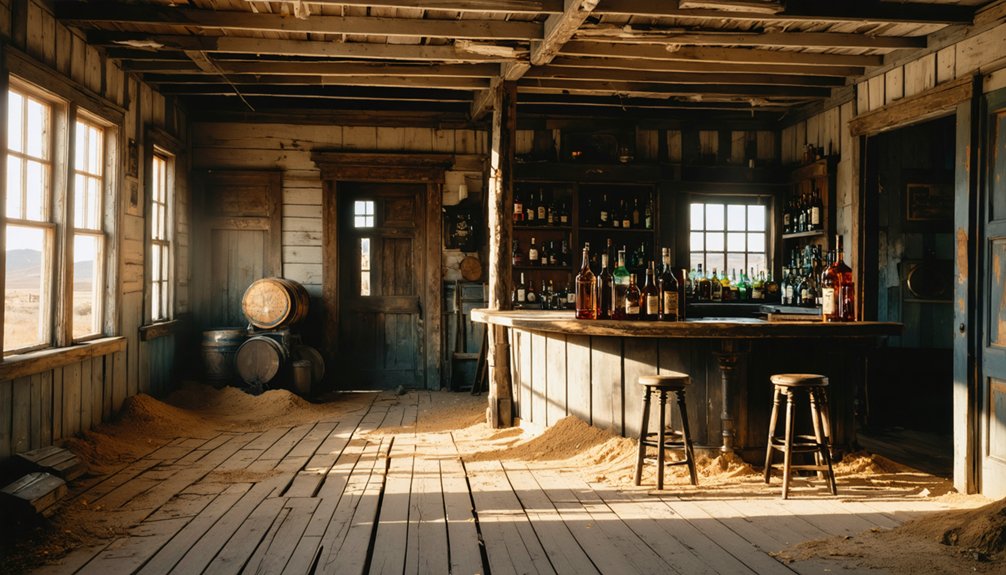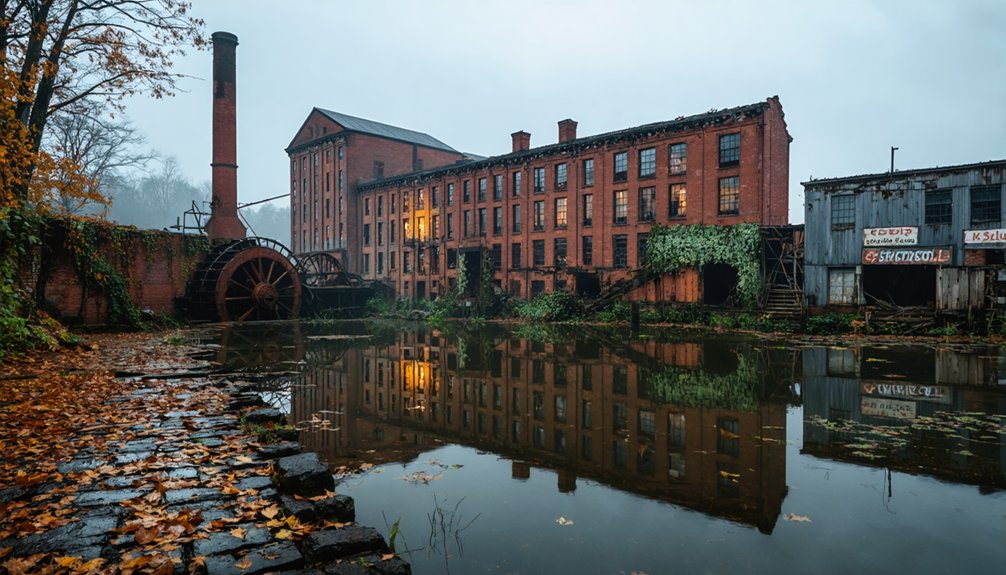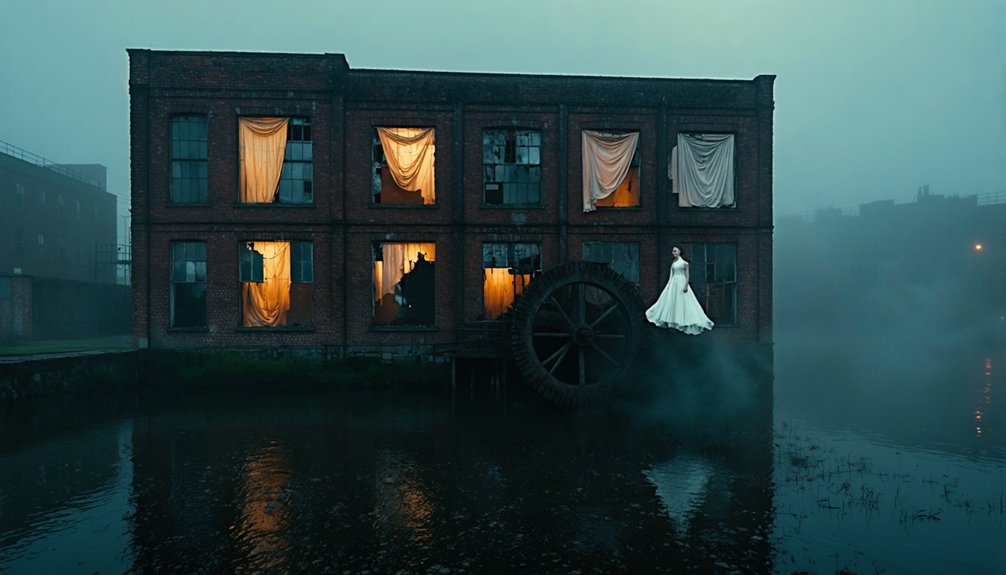You’ll find America’s most haunting ghost towns scattered across the landscape, each telling unique stories of boom and bust. Bodie, California preserves a gold rush era frozen in the 1880s, while Centralia, Pennsylvania smolders with underground fires burning since 1962. St. Elmo, Colorado maintains 43 original structures reportedly guarded by ghosts. Frisco, Utah displays remnants of its lawless past, and Bannack, Montana showcases 60 historic buildings where vigilante justice once ruled. These abandoned communities await your exploration.
Key Takeaways
- Bodie, California features 65 former saloons and thousands of structures preserved in “arrested decay” since the 1880s gold rush decline.
- Centralia, Pennsylvania has been burning underground since 1962, forcing evacuation of nearly all residents due to toxic gases and sinkholes.
- St. Elmo, Colorado contains 43 original structures from its 1880s mining heyday, reportedly haunted by the ghost of “Dirty Annie” Stark.
- Frisco, Utah earned a reputation as the “toughest mining town” with 23 saloons and daily murders during its 1870s silver boom.
- Bannack, Montana features 60 preserved buildings and a dark history of corrupt law enforcement and vigilante justice from the 1860s gold rush.
Bodie, California: The Gold Rush Town Frozen in Time
As gold was discovered in 1859 by prospectors in the eastern Sierra Nevada foothills, Bodie’s remarkable story began with a tragic irony—the town was named after W.S. Bodey, who perished in a blizzard while returning for supplies.
A painter’s misspelling gave us the name “Bodie” that endures in ghost town history.
The settlement remained secret until a mine cave-in revealed rich gold in 1876, launching Bodie into boomtown status.
By the late 1870s, you’d have found yourself among 8,000-10,000 residents in a thriving community with 65 saloons and modern amenities like electricity and indoor plumbing.
Bodie history took a turn as mines depleted in the 1880s.
After devastating fires in 1892 and 1932, the town declined until its preservation in “arrested decay” as a state park in 1962.
The town’s notorious reputation earned it the phrase “Badman from Bodie” by 1880, marking it as one of the West’s wildest mining communities.
Today, visitors are warned against taking souvenirs due to the legendary curse of Bodie that supposedly brings misfortune to anyone who removes items from the town.
Centralia, Pennsylvania: The Town That’s Still Burning
While thousands of abandoned towns dot America’s landscape, none has a more alarming distinction than Centralia, Pennsylvania, where the ground has been burning since 1962.
What began as an accidental trash fire ignited an exposed coal seam beneath the town, creating an unstoppable underground inferno that reaches temperatures exceeding 900 degrees Fahrenheit.
Centralia’s history transformed dramatically as toxic gases and dangerous sinkholes forced most residents to flee. In 1980, awareness of the fire’s dangers increased after a young boy nearly died when he fell into a sudden sinkhole that opened beneath him. The population plummeted from 1,300 in 1962 to just five people by 2020, after the U.S. government bought out properties and demolished infrastructure.
A government-condemned ghost town where flames consume the earth below, Centralia stands as a cautionary environmental tale.
Today, the abandoned town has become a macabre tourist attraction, with the infamous Graffiti Highway serving as an artistic canvas where the heat has deformed the asphalt.
You’ll find warning signs throughout the area, as the fire continues its relentless burn beneath the surface. Experts estimate this underground fire could continue for another 250 years, leaving behind a haunting evidence of environmental disaster.
St. Elmo, Colorado: Where the Past Lives On
Perched at nearly 10,000 feet in Colorado’s majestic Sawatch Mountain Range, St. Elmo stands as one of America’s best-preserved ghost towns. Founded in 1880 and originally named Forest City, this once-thriving mining community boasted nearly 2,000 residents during its gold and silver boom.
The Mary Murphy Mine fueled St. Elmo’s prosperity, generating over $60 million in gold before closing in 1922. When the railroad service ended that same year, the population vanished almost overnight, leaving behind 43 original structures.
You’ll find the town’s mining history evident in every weathered building. The Stark family’s preservation efforts saved St. Elmo from disappearing entirely. The town offers a rich historical experience with wood-framed and log buildings still standing despite decades of neglect. Visitors can explore the surrounding area on various trails using four-wheel-drive vehicles available for rent in nearby towns.
Today, visitors regularly report ghostly sightings of “Dirty Annie” Stark, who allegedly patrols the streets with her spectral shotgun, protecting the town she refused to abandon even in death.
Frisco, Utah: Wild West Remnants in the Desert
Hidden among the barren hills of Utah’s Great Basin, Frisco emerged as a silver boomtown in 1875 after prospectors discovered rich ore deposits in the nearby San Francisco Mountains.
The town quickly gained notoriety as “the toughest mining town in the West,” where silver mining prosperity brought a lawlessness legacy including 23 saloons, brothels, and daily murders.
When officials hired a marshal from Nevada, he reportedly killed six outlaws his first night and offered the rest an ultimatum: leave or die. Most chose exile, temporarily taming the wild settlement.
The catastrophic Horn Silver Mine collapse in 1885 sealed Frisco’s fate. Though no lives were lost, the town’s economic lifeblood was cut off. The region had yielded an impressive $60 million in various minerals during its decade of peak production. Today, visitors can still see visible remnants of past structures amid the desolate landscape, highlighting Frisco’s historical significance as a once-thriving mining town.
Bannack, Montana: From Boom to Historic Ghost Town
Nestled in the rugged Montana wilderness, Bannack emerged as a gold rush boomtown after prospectors discovered significant deposits in 1862.
Named for the Bannock tribe, the settlement rapidly swelled to 10,000 residents and briefly served as Montana’s territorial capital.
Under Sheriff Henry Plummer‘s corrupt leadership, crime escalated dramatically.
Ironically, Plummer himself allegedly led the “Innocents” gang responsible for over 100 gold robberies.
Vigilante justice prevailed when townspeople executed Plummer and his deputies in January 1864.
The town’s most notorious site, Hotel Meade, is reportedly haunted by the ghost of Dorothy Dunn, a young girl who drowned in 1916.
Bannack’s decline began with the Alder Gulch gold discovery, accelerated by Native American attacks and an 1895 fire, and culminated in complete abandonment by the 1960s.
Today, you’ll find 60 meticulously preserved buildings as part of Bannack State Park, designated a National Historic Landmark in 1961.
The popular Bannack Days celebration brings history to life with reenactments and demonstrations that transport visitors back to the 1860s frontier experience.
Frequently Asked Questions
What Safety Precautions Should Visitors Take When Exploring Ghost Towns?
In the most perilous ghost towns, you’ll need proper safety gear including sturdy boots, gloves, and respirators. Maintain wildlife awareness by scanning for snakes. Respect property boundaries, avoid unstable structures, and always explore with companions.
How Accessible Are These Ghost Towns During Winter Months?
Winter accessibility varies dramatically. You’ll face impassable roads, requiring snowmobiles or snowshoes at high elevations. Weather considerations include monitoring storm forecasts, as single storms can instantly change conditions overnight.
Are There Any Guided Night Tours Available for Paranormal Experiences?
Yes, numerous guided night ghost tours and paranormal investigations are available year-round, with increased options during Halloween. You’ll need advance reservations, as walk-ups aren’t accepted due to high demand.
What Photography Equipment Works Best for Capturing Ghost Town Atmospheres?
You’ll capture mind-blowingly haunting atmospheres with a full-frame camera, adjustable camera settings for long exposures, wide-angle lenses for architecture, and fast prime lenses for low-light interiors. Don’t forget your tripod!
Can Visitors Stay Overnight in Any of These Locations?
Yes, you’ll find diverse overnight accommodations at ghost towns like St. Elmo’s Guest House, Gold Point’s B&B, and Terlingua’s Holiday Hotel, plus nearby camping options at Bodie and various Nevada locations.
References
- https://nightofthejack.com/2025/01/23/top-creepy-ghost-towns-in-america/
- https://www.tastingtable.com/694562/scariest-ghost-towns-country/
- https://www.loveexploring.com/gallerylist/131658/abandoned-in-the-usa-92-places-left-to-rot
- https://www.businessinsider.com/eeriest-things-seen-while-exploring-abandoned-ghost-towns-2022-10
- https://www.christywanders.com/2024/08/top-ghost-towns-for-history-buffs.html
- https://www.youtube.com/watch?v=SUsnGxOpcss
- https://www.geotab.com/ghost-towns/
- https://en.wikipedia.org/wiki/List_of_reportedly_haunted_locations_in_the_United_States
- https://www.youtube.com/watch?v=Z69cNeuZGsA
- https://www.youtube.com/watch?v=iNEJyuneSDM



